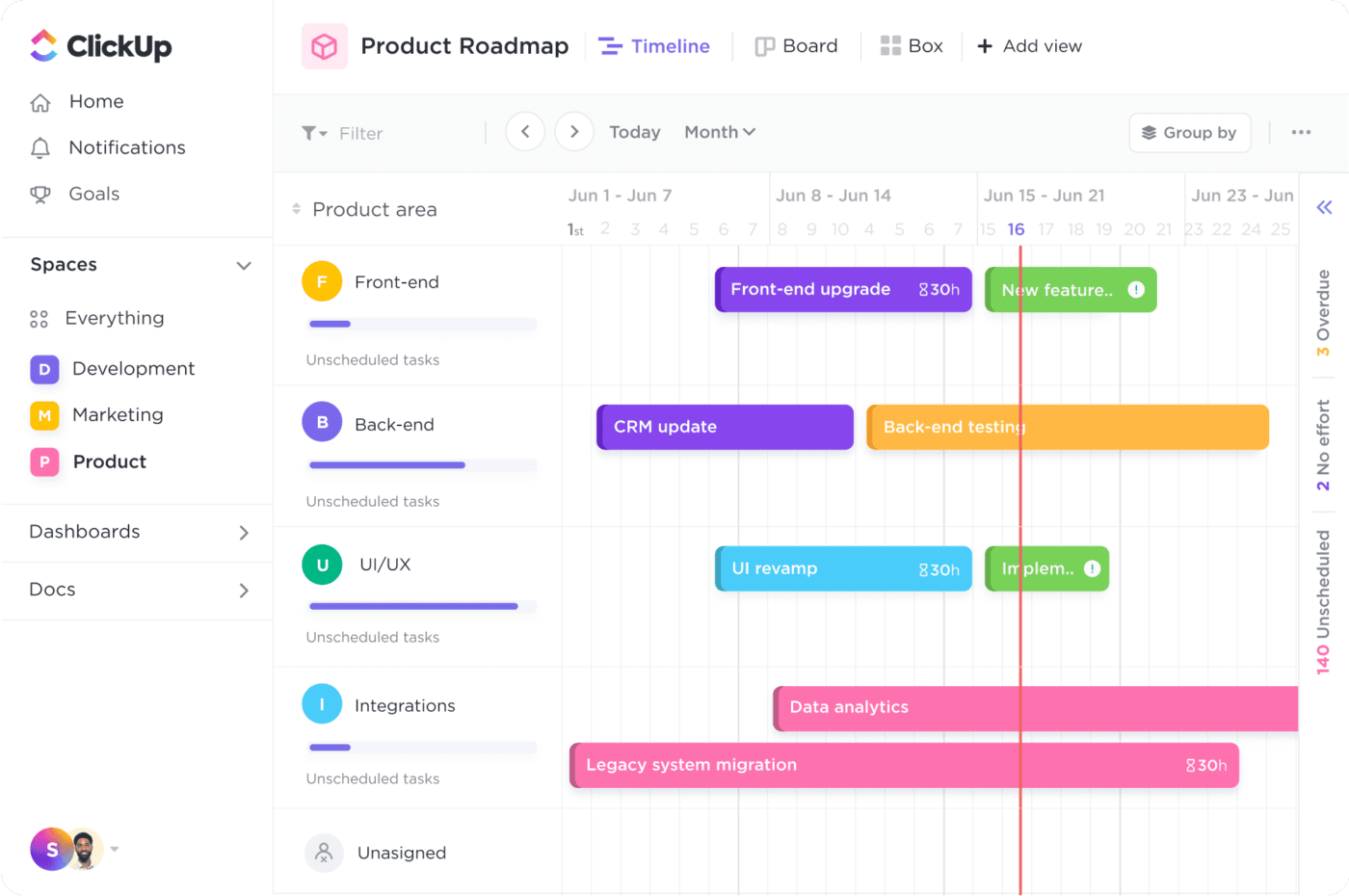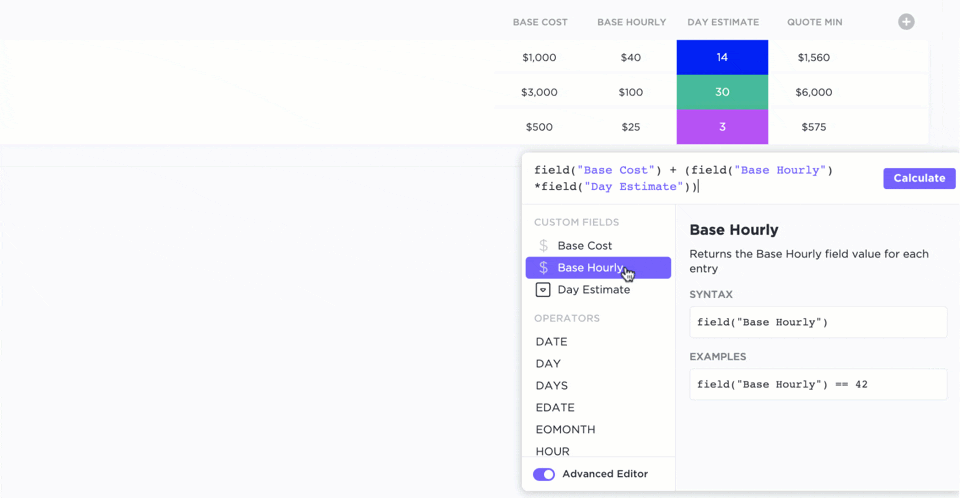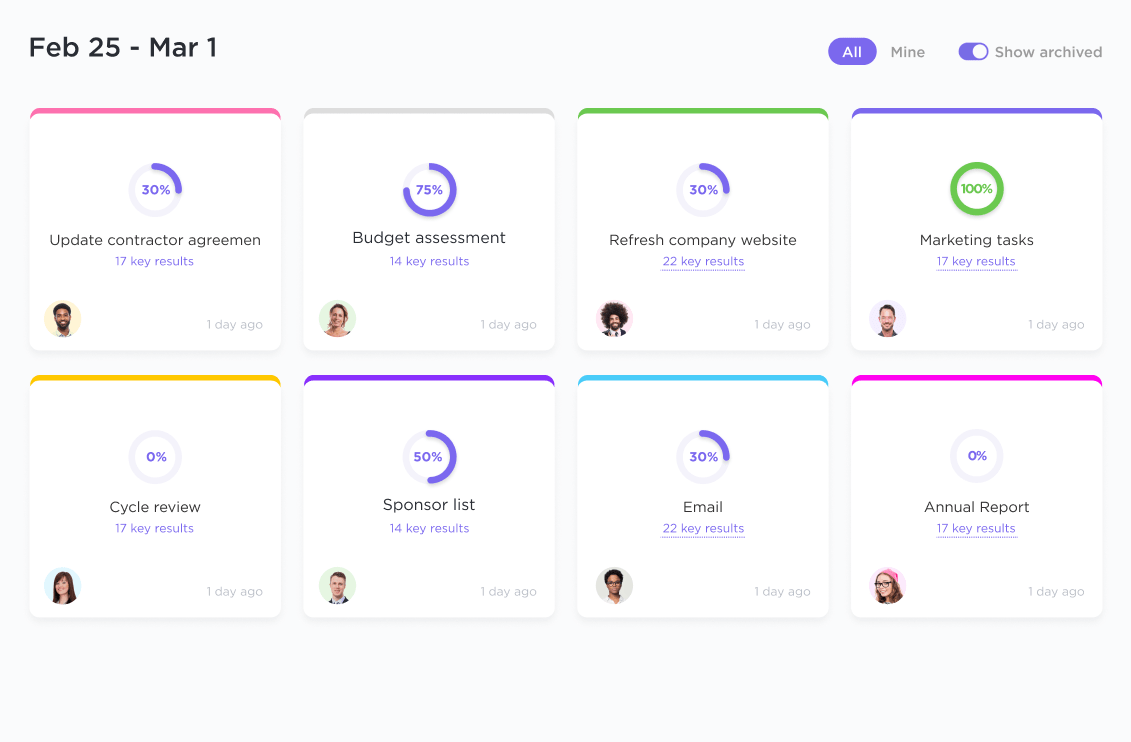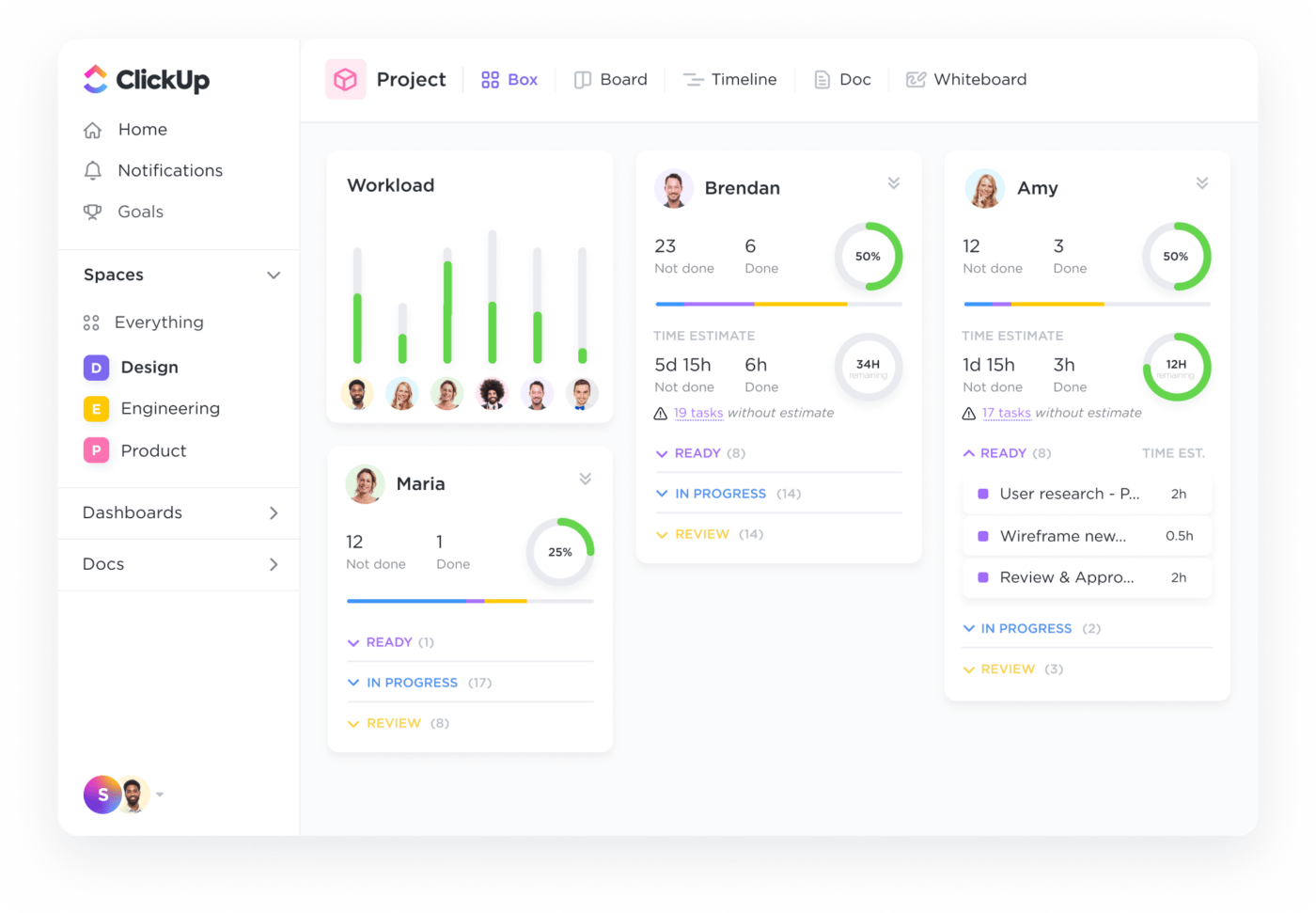"السلامة خير من الندم" عبارة مبتذلة، أليس كذلك؟
ومع ذلك، يهمل بعض مديري المشاريع الحصول على البيانات التي يمكن أن تساعدهم في منع المشاريع من الخروج عن مسارها. ولكن إليكم الأمر: حتى أكثر البيانات التي تم وضعها بعناية فائقة خطط المشروع ليست خالية من المشاكل
وتكاد المشاكل تظهر حتماً طوال دورة حياة المشروع. يمكن أن تكون انحرافات عن أهداف المشروع أو فشل المشروع بالكامل
وبغض النظر عن ذلك، فإن تجنب هذه المشاكل في الوقت المناسب هو مهمة مدير المشروع والغرض من مؤشرات الأداء الرئيسية لإدارة المشروع.
تابع القراءة وتعرف على مجموعتنا المختارة من مؤشرات الأداء الرئيسية لإدارة المشاريع (مع أمثلة). نريدك أن تتعرف على معنى كل مؤشر وتحديد المؤشرات الأكثر أهمية بالنسبة لأداء مشروعك.
ما هي مؤشرات الأداء الرئيسية لإدارة المشاريع؟
مؤشرات الأداء الرئيسية لإدارة المشاريع - أو مؤشرات الأداء الرئيسية - هي المتغيرات ذات الصلة لقياس أداء المشروع أو المسار المؤدي إلى إنجاز المشروع بنجاح. وللمؤشرات التي تحصل عليها من قياس تلك المتغيرات وأحيانًا الجمع بينها غرضان:
- تحدد مؤشرات الأداء الرئيسية في إدارة المشروع التقدم المحرز في مشروعك (أو الجدول الزمني للمشروع)
- تكشف مؤشرات الأداء الرئيسية في إدارة المشروع عن نقاط الضعف في مشروعك والمتغيرات المحتملة التي من شأنها أن تؤدي إلى الفشل
على سبيل المثال، قد تكشف مؤشرات الأداء الرئيسية الخاصة بك عن نقاط الضعف في عملية ما أو مهمة أو مهمة ما. ولكن الأمر متروك لك بصفتك مدير المشروع أو قائد الفريق لإجراء التصحيحات أو التحسينات اللازمة لإزالة أو تعزيز تلك النقاط قبل فوات الأوان.

كيف يتم استخدام مؤشرات الأداء الرئيسية لتحديد المشروع الناجح
لا تعتمد مؤشرات الأداء الرئيسية في إدارة المشاريع على الذاتية. وبدلاً من ذلك، فإنها تعتمد على البيانات الكمية - وهي في الغالب قيمة قابلة للقياس يمكنك وضعها مقابل أهداف مشروعك.
ومع ذلك، يجب ألا تستخدم مؤشرات الأداء الرئيسية في إدارة المشروع ومقاييس الأداء بالتبادل. لأن مؤشرات الأداء الرئيسية هي مقاييس - فكلاهما يقيس نجاح المشروع. ولكن ليست كل المقاييس مهمة بما يكفي لتصبح مؤشرات أداء رئيسية.
اقرأ مقالنا عن مقاييس مؤشرات الأداء الرئيسية ستصادفها كإطار عمل لتحديد الأهداف، بينما تقيس مؤشرات الأداء الرئيسية العوامل التي تساهم في تحقيق تلك الأهداف والنتائج المرجوة.

توفر طريقة عرض عبء العمل ClickUp Workload View رؤى حول مقاييس مشروعك لتكون متقدمًا بخطوة إلى الأمام
يجب أن يتوصل فريق المشروع بشكل عام إلى اتفاق حول مؤشرات الأداء الرئيسية لتقييم سلامة المشروع ومعرفة شكل النجاح. ولكن أهدافك ليست مجرد إجابات على تحديات إدارة المشروع ، فهي التي ستحدد اتجاه ومنطق مشروع معين.
_إذا كنت بحاجة إلى مزيد من المعلومات للفصل بين الاثنين بشكل أفضل، راجع موقعنا دليل إلى OKRs مقابل مؤشرات الأداء الرئيسية !
15 مؤشر أداء رئيسي لإدارة المشاريع تحتاج إلى معرفته
الكثير أمثلة على مؤشرات الأداء الرئيسية لإدارة المشاريع هناك في انتظارك للعثور عليها. لكننا نريدك أن تركز على عدد قليل منها فقط حتى تفهم الصلة بين مؤشرات الأداء الرئيسية للمشروع والأهداف.
بالإضافة إلى ذلك، فإن تعلم عدد محدود من مؤشرات الأداء الرئيسية للبدء بها يساعدك في أن تكون انتقائيًا. لأن الميل إلى استخدام جميع مؤشرات الأداء الرئيسية لإدارة المشاريع على وجه الأرض يؤدي إلى نتائج عكسية.
يجب عليك تجاهل مؤشرات الأداء الرئيسية التي لا تشير في الواقع إلى نجاح مشروعك. ولن تتطور قدرتك على تحديد تلك المؤشرات إلا بالخبرة.
لا يمكنك أيضًا أن ترهق مديري وفرق مشروعك بالكثير من البيانات. يجب أن تكون كل مؤشرات الأداء الرئيسية ذات مغزى وبكميات قابلة للهضم حتى يتمكن فريقك من التصرف بناءً عليها. يجب أن تعتمد على مؤشرات الأداء الرئيسية في إدارة المشروع لإعادة مواءمة الفريق مع أهدافك العامة.
قمنا بتنظيم قائمة منسقة من مؤشرات الأداء الرئيسية حسب أربعة مجالات مشتركة لنجاح المشروع:
مؤشرات الأداء الرئيسية لميزانية المشروع
إن إدارة أموال المشروع وموارده المدفوعة بدون ميزانية ستكون كارثة تنتظر الحدوث. وبصراحة تامة، سيكون ذلك غير مسؤول من الناحية المالية. لهذا السبب يضع مديرو المشاريع ميزانية فعلية عند بدء المشروع مباشرةً. ويراقبون باستمرار التباين في التكلفة مقابل التباين في الميزانية طوال فترة إنجاز المشروع.

من السهل إضافة قيم مالية إلى المهام لإبقاء ميزانيات المشاريع على المسار الصحيح
قد تحتاج إلى زيادة أو تخفيض ميزانية مشروعك بسبب النفقات أو المشاريع الملغاة. بالإضافة إلى ذلك، قد ترغب في إعادة تخصيص ميزانية المشروع بأكملها أو أجزاء منها فقط لأنشطة أو حزم عمل أخرى أو حتى عبر مشاريع متعددة.
دعنا نلقي نظرة على بعض مؤشرات الأداء الرئيسية للمشروع من أجل إدارة ميزانيتك بشكل أكثر فعالية:
1. مؤشر أداء التكلفة (CPI)
المعادلة: مؤشر أداء التكلفة = EV / AC، حيث
- EV (أو القيمة المكتسبة، والتي تعني التكلفة المخططة للعمل الفعلي المنجز) = النسبة المئوية للعمل المنجز * الميزانية لإنجاز 100% من العمل
- AC (أو التكلفة الفعلية) = الأموال التي تم إنفاقها على العمل المنجز
النتيجة: إذا كان مؤشر أسعار المستهلكين < 1، فهذا يعني أن تكلفة المشروع حاليًا أعلى من المتوقع.
أنشئ ميزانية باستخدام
_/مرجع/ *مدونة؟ p=70917_ قوالب مقترحات الميزانية *%/href/_
!
2. تباين التكلفة (السيرة الذاتية)
المعادلة: السيرة الذاتية = EV - AC
النتيجة: إذا كانت السيرة الذاتية < 0، فإن التكلفة الفعلية للمشروع حاليًا أعلى من التكلفة المتوقعة.
3. القيمة المخططة (PV)
المعادلة: PV = BAC \ * العمل المقرر، حيث
- BAC (الميزانية عند الإكمال) = الميزانية المعتمدة
- العمل المجدول = العمل المتوقع إنجازه في وقت معين
مثال: القيمة الفعلية هي 23,000 دولار أمريكي إذا كان من المتوقع أن تبلغ تكلفة العمل 100,000 دولار أمريكي بنسبة 100%، وتمت جدولة 77% من العمل.
الطلب في ميزانيتك المخطط لها نصيحة للمحترفين: قارن بين القيمة الفعلية للعمل وميزانية مشروعك وفقًا لذلك للحصول على أفضل عائد على الاستثمار العائد على الاستثمار . استخدم هذه المعلومات في المشاريع المستقبلية واستمر في التقييم للحصول على معلومات أكثر دقة.
4. وقت دورة إنشاء الميزانية
هذا هو الوقت المستغرق في وضع ميزانية المشروع. وتشمل جميع الأنشطة - وخاصة التخطيط - التي ينطوي عليها التوصل إلى الميزانية الأكثر واقعية والاتفاق عليها.
ما هي القيمة المخطط لها نصيحة للمحترفين: قم بربط مؤشر الأداء الرئيسي هذا بمؤشرات الأداء الرئيسية الأخرى لفهم ما إذا كان الوقت المستغرق في الميزانية المخططة كافٍ لتلبية نجاح المشروع أو أهدافه .
5. عدد البنود في الميزانية
في ميزانية البنود، يتم تجميع النفقات في ميزانية البنود حسب الفئات، مثل المراحل أو حزم العمل. يشير انخفاض عدد البنود في هذا النوع من الميزانية إلى أن تتبع الإنفاق في الميزانية سيكون أصعب.
6. عدد مرات تكرار الميزانية
هذا هو عدد الإصدارات التي خضعت لها ميزانية مشروعك قبل الموافقة النهائية عليها. يشير عدد التكرارات الكثيرة إلى أن مديري مشروعك على الأرجح قضوا وقتًا كافيًا في تخطيط الميزانية، كما هو متوقع.
هي التكلفة المدرجة في الميزانية التي تؤدي إلى النجاح نصيحة للمحترفين: قارن مؤشر الأداء الرئيسي هذا بمؤشرات أخرى لكشف العلاقة بين وقت تخطيط الميزانية ونجاح المشروع. سيساعدك هذا على قياس التقدم المحرز نحو
حسن التوقيت
ببساطة، تتعلق إدارة المشاريع بأمرين: المال والوقت. والهدف هو الوصول إلى كل المعالم الرئيسية على الميزانية وفي الوقت المحدد.
ولكن إذا كان مشروعك يحتوي على الكثير من المراحل وحزم العمل والأنشطة، فهذا يمثل تحديًا كبيرًا. يصبح تقدير عدد المهام التي ستنفذها، والمدة الزمنية اللازمة لإنجاز تلك المهام، والموارد المتاحة، وتباين جدولك الزمني أمراً معقداً.

تصور خارطة طريق منتجك وإدارتها في ClickUp Timeline View
ونتيجة لذلك تنفيذ المشروع قد يتأخر عن الجدول الزمني المحدد، وتخسر الشركات أموالها. إليك بعضًا من مؤشرات الأداء الرئيسية للجدول الزمني للمشروع لمساعدتك على تجنب تفويت معالمك الرئيسية حتى يبقى فريقك بأكمله في الموعد المحدد.
7. مؤشر أداء الجدول الزمني (SPI)
المعادلة: SPI = EV / PV
مثال: إذا تم إنجاز 53% من العمل المخطط له وكانت ميزانية إنجاز 100% من العمل 100,000 دولار، فإن مؤشر أداء الجدول الزمني يساوي 0.53 (أو 53%). والحساب هو (53% * 100,000 دولار) / 100,000 دولار.
النتيجة: إذا كان مؤشر SPI < 1، فهذا يعني أن المشروع متأخر حاليًا عن الجدول الزمني.
هل القيمة المخطط لها منطقية بالنسبة لـ spi نصيحة للمحترفين: ضع في اعتبارك زيادة كفاءة مواردك إذا كان مؤشر الأداء الخاص بمشروعك < 1.
8. تباين الجدول الزمني (SV)
المعادلة: SV = EV - PV
النتيجة: إذا كان SV < 0، فهذا يعني أن المشروع متأخر حاليًا عن الجدول الزمني.
تنبيه: يتم التعبير عن القيمة الافتراضية بوحدات نقدية، مثل الدولارات، وليس بوحدات زمنية، مثل الأيام أو الأشهر.
هل القيمة المخططة منطقية بالنسبة لسبك نصيحة للمحترفين: ضع في اعتبارك زيادة كفاءة مواردك إذا كان مؤشر أداء الجدول الزمني لمشروعك <1.
9. سعة الموارد (RC)
المعادلة: سعة الموارد = ساعات العمل المتاحة يوميًا * عدد أيام العمل المخصصة للمشروع
أفضل الممارسات *RC نصيحة احترافية: اضبط الجدول الزمني للمشروع ليتناسب مع سعة مواردك أو استعن بالمزيد من أعضاء الفريق لرفع سعة الموارد. مقدار الوقت اليومي المتاح يجب أن يستثني فترات الراحة. نظرًا لأنك تقوم بحساب المنسق المقيم لمشروع معين، يجب أن تستبعد الوقت الذي تقضيه في مشاريع أخرى.
10. نسبة الإنجاز في الوقت المحدد
المعادلة: (عدد المشاريع المنجزة في الوقت المحدد / إجمالي عدد المشاريع) * 100%
حدد مستويات الأداء، خاصةً مستوى أداء ناقص، لنقل 90٪. ثم اعتبر أي مدير مشروع يقل معدل إنجازه في الوقت المحدد عن هذا المستوى على أنه ضعيف الأداء وأشر إليه ب خطة تحسين الأداء .
11. الساعات المخططة مقابل الساعات الفعلية
المعادلة: المدة المخطط لها - المدة الفعلية، حيث المدة المخطط لها هي الوقت المقرر لتنفيذ العمل، وهي تقديرية
النتيجة: إذا كانت النتيجة: إذا كانت <0، فهذا يعني أنك قللت من وقت الجدول الزمني للمشروع.
الجودة
تقيّم مؤشرات الأداء الرئيسية التالية مدى جودة تنفيذ مشاريعك. كما أنها تحدد أيضًا ما إذا كانت النتائج التي تم تسليمها تلبي توقعات أصحاب المصلحة بما يتجاوز المهام المنجزة فقط.
تخبرك بعض مؤشرات الأداء الرئيسية للجودة ما إذا كانت جودة العمل المنجز ضمن مشاريعك إيجابية. وتخبرك مؤشرات أداء رئيسية أخرى للجودة ما إذا كانت البيئة التي نفذت فيها فرقك مشاريعك إيجابية. بعبارة أخرى، مؤشرات الأداء الرئيسية للجودة هي مقاييس لسعادة العملاء أو الموظفين.
12. معدل تخبط الموظفين
المعادلة: (عدد الموظفين الذين تركوا شركتك / متوسط عدد الموظفين) * 100
النتيجة: من المرجح أن يؤدي ارتفاع معدل تخبط الموظفين إلى عدم كفاءة المشروع، مثل عدم تحقيق الأهداف، والنفقات غير المتوقعة، وفي نهاية المطاف، انخفاض رضا العملاء.
13. صافي نقاط المروجين (NPS)
يقيّم مؤشر الأداء الرئيسي هذا رضا العملاء وولاءهم للعلامة التجارية من خلال استبيان من سؤال واحد. NPS عبارة عن رقم يتراوح بين -100 و100، وتستهدف الطرف الأعلى.
إذا كنت تمتلك أو إدارة مشاريع لمنتج واحد شركة أو علامة تجارية، سيكون سؤال الاستطلاع: "ما مدى احتمالية أن توصي بمنتجنا لأصدقائك وزملائك"؟ وإذا كنت تملك أو تدير مشاريع لعلامة تجارية متعددة المنتجات، يمكنك تعديل السؤال وذكر "العلامة التجارية" بدلاً من "المنتج"
يقوم المشاركون في استطلاع NPS بتقييم احتمالية التوصية بمنتجك أو علامتك التجارية على مقياس من 0 إلى 10، حيث يكون الصفر غير مرجح للغاية والعشرة مرجحة للغاية. ثم، بناءً على إجاباتهم، ينقسم المستجيبون إلى ثلاث فئات.
- المروجون. مع درجة تسعة أو عشرة، المروجون هم العملاء المخلصون المتحمسون لمنتجك أو علامتك التجارية ومن المرجح أن يحيلوا عرضك إلى الآخرين.
- السلبيون. الذين حصلوا على سبع أو ثمانية، هم عملاء سلبيون راضون عن منتجك أو علامتك التجارية. ومع ذلك، فهم غير راضين بما فيه الكفاية لنشر الخبر عنه، مما يجعلهم عرضة للعروض التنافسية.
- المنتقدون. مع درجة من 0-6، فإن المنتقدين غير راضين عن منتجك أو علامتك التجارية ومن المحتمل ألا يشتروا منك مرة أخرى. في الواقع، قد يقنعون الآخرين بعدم الشراء منك.
المعادلة: % من المروجين - % من المنتقدين

قم بإنشاء نماذج مخصصة في ClickUp لالتقاط الملاحظات، وتحويل الردود على الاستبيان إلى مهام قابلة للتنفيذ - كل ذلك في مكان واحد
حوّل المنتقدين إلى مروجين لتعزيز مستويات ولاء عملائك. يمكنك إنشاء نماذج مخصصة نماذج مخصصة للحصول على تعليقات نقدية من عملائك لمساعدتك على زيادة NPS الخاص بك.
الفعالية
تقيس مؤشرات الأداء الرئيسية أدناه فعالية مشروعك من حيث التكلفة. وهذا يرتبط ارتباطًا وثيقًا بكيفية استخدامك لمواردك.
هل يقضون الوقت في عمل المشروع بفعالية؟ وهل تنفق أموالك على مواردك بفعالية؟
بمعنى آخر، هل تنفق على مشروعك وقتاً ومالاً أكثر من الأموال التي ستحاسب بها عملاءك؟ مؤشرات الأداء الرئيسية للفعالية هي مؤشرات لمساعدتك في استخلاص استنتاجات حول التباين في التكلفة عبر المشاريع.
14. الاستخدام القابل للفوترة
هذا هو مؤشر الأداء الرئيسي الخاص بك لتقييم أداء أعضاء فريقك أثناء تنفيذ أعمال المشروع. فهو يمنحك نظرة ثاقبة على الوقت الذي يقضيه فريقك في تحقيق الإيرادات والإيرادات التي ستحصل عليها بالفعل من عملائك.
المعادلة: (عدد الساعات المدفوعة الأجر/عدد الساعات التي قضاها أعضاء فريقك في تنفيذ أعمال المشروع) * 100%
تجنب إرهاق فريقك نصيحة احترافية: امتنع عن استهداف أقصى استفادة. سيؤدي ذلك إلى زيادة إيراداتك إلى الحد الأقصى، لكن فريق عملك سيكون معرضًا لخطر الإرهاق، وهو ما سيكلفك ثمنًا باهظًا.
15. متوسط التكلفة لكل ساعة
اجمع كل تكاليف توفير الظروف الملائمة لموظفيك لتنفيذ مشروعك بنجاح. قد تتراوح هذه التكاليف من الرواتب ومزايا الموظفين إلى المعدات المكتبية، على سبيل المثال لا الحصر.

ابحث عن تكلفة الحملات بأكملها، والساعات المدفوعة والمزيد باستخدام الصيغ المتقدمة في ClickUp Custom Fields
قارن متوسط التكلفة لكل ساعة مع نتائج مشروعك. إذا كان الأخير يفوق الأول، فهذا يعني أن موظفيك استخدموا وقت المشروع أو الساعات المخطط لها بفعالية. ونتيجة لذلك، فقد أنفقت أموالك بفعالية أيضاً!
من المستفيد من إعدادات مؤشرات الأداء الرئيسية؟
الشركات: أي شركة تتطلع إلى تحسين العمليات باستمرار، ومراقبة الأداء، وضمان نجاح المشروع بشكل عام ستستفيد من إعداد مؤشرات الأداء الرئيسية. فهي تضيف مقياسًا قابلاً للقياس الكمي للأهداف، مما يسهل على الشركات تتبع التقدم المحرز واتخاذ قرارات قائمة على البيانات. توفر مؤشرات الأداء الرئيسية للشركات القدرة على الحصول على نظرة ثاقبة في الوقت الفعلي لعملياتها وتصحيح المسار إذا لزم الأمر.
- مؤشرات الأداء الرئيسية لأعمال البيع بالتجزئة
- مؤشرات الأداء الرئيسية لأعمال التصنيع
- مؤشرات الأداء الرئيسية لأعمال التجارة الإلكترونية
- مؤشرات الأداء الرئيسية للأعمال القائمة على الخدمات
مديري المشاريع: بالنسبة لمديري المشاريع، يعد وضع مؤشرات الأداء الرئيسية أمرًا بالغ الأهمية للتشغيل السلس للمهام وتحقيق أهداف المشروع. وتوفر مؤشرات الأداء الرئيسية خارطة طريق واضحة للنتائج المتوقعة، مما يخفف من تعقيد المشاريع المعقدة إلى أجزاء يمكن التحكم فيها. كما أنها توفر لمديري المشاريع طريقة لقياس ما إذا كان الفريق يسير على المسار الصحيح أو إذا كانت هناك حاجة لإجراء تعديلات وبالتالي تقليل المخاطر التي ينطوي عليها الأمر.
- مؤشرات الأداء الرئيسية لإدارة المشاريع الإنشائية
- مؤشرات الأداء الرئيسية لعمليات تكنولوجيا المعلومات
- مؤشرات الأداء الرئيسية للتسويق الرقمي
- مؤشرات الأداء الرئيسية لمخطط الفعاليات
كيفية تتبع مؤشرات الأداء الرئيسية لإدارة المشاريع ## كيفية تتبع مؤشرات الأداء الرئيسية لإدارة المشاريع
بعد اختيار مؤشرات الأداء الرئيسية الخاصة بك لإدارة المشروع، يجب عليك أو على مديري المشروع الخاص بك مراقبتها.
يمكنك البدء بإنشاء لوحة معلومات مؤشرات الأداء الرئيسية في Excel . ولكن إذا كان مشروعك معقدًا بميزانيات كبيرة، ويحتاج إلى العديد من أصحاب المصلحة والموارد، وينطوي على العديد من القيود على الجدول الزمني وتبعيات المهام، فأنت بحاجة إلى نهج أكثر قوة لإدارة المشروع!
وهنا يأتي دورنا مع ClickUp. برنامج مؤشرات الأداء الرئيسية لدينا يزودك ب تقارير مؤشرات الأداء الرئيسية التي تحتاجها، مهما كان ذلك. ومجموعة ClickUp الخاصة بـ قوالب إدارة المشاريع يمنحك السبق. فهو يبسط إعداد المشاريع مع تكوين تقارير مؤشرات الأداء الرئيسية الخاصة بك.

تتبع أهدافك وصولاً إلى مؤشرات الأداء الرئيسية الأكثر أهمية واحصل تلقائيًا على مشاهدات مفصلة عن تقدمك
بالإضافة إلى ذلك، يتيح لك ClickUp ربط المهام من فرق مختلفة بهدف واحد قابل للقياس. إلى جانب الجداول الزمنية المحددة بوضوح، يمكّنك برنامجنا من تتبع الأهداف تلقائياً. ولكن الأمر لا يتوقف عند هذا الحد! استخدم ClickUp لتتبع إنجاز المراحل وحتى OKRs.
اربط المهام بالأهداف. بعد ذلك، قم بتنظيم الأهداف ذات الصلة في مجلدات لتتبع التقدم المحرز بشكل تلقائي وشامل في مكان واحد. جرِّب ما يلي أهداف ClickUp واكتشف كيف تبدو المراقبة المناسبة لمؤشرات الأداء الرئيسية لإدارة المشاريع!

